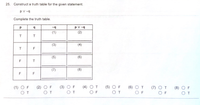
Advanced Engineering Mathematics
10th Edition
ISBN: 9780470458365
Author: Erwin Kreyszig
Publisher: Wiley, John & Sons, Incorporated
expand_more
expand_more
format_list_bulleted
Question

Transcribed Image Text:25. Construct a truth table for the given statement.
pv -q
Complete the truth table.
pv -q
(1)
(2)
(3)
(4)
(5)
(6)
F
(7)
(8)
(1) O F
OT
(2) O F
O T
(4) O T
O F
(5) O F
O T
(6) OT
O F
(7) OT
O F
(3) O F
(8) O F
OT
Expert Solution
arrow_forward
Step 1

Step by stepSolved in 2 steps with 2 images

Knowledge Booster
Similar questions
- do not handwrite this.arrow_forward21. Let the following predicates be given. The domain is all computer science classes. I(r) = "x is interesting." U(x) = "x is useful." H(x, y) = “x is harder than y." M(x, y) = “x has more students than y." (a) Write the following statements in predicate logic. i. All interesting CS classes are useful. ii. There are some useful CS classes that are not interesting. iii. Every interesting CS class has more students than any non- interesting CS class. (b) Write the following predicate logic statement in everyday English. Don't just give a word-for-word translation; your sentence should make sense. (3)[I(x) A (Vy)(H(x,y)→ M(y, x))] (c) Formally negate the statement from part (b). Simplify your negation so that no quantifier lies within the scope of a negation. State which derivation rules you are using. (d) Give a translation of your negated statement in everyday English.arrow_forwarddetermine the truth value of each of the statements below. Justify your responses. (a) (3m € N) (n = N) 4m + 7n = 17. (b) (Vm € N)¬(³n € N) m² — n² = 7. (c) (Vm € N) (Vn € N) ((m ≤n) V (n ≤ m)) ⇒ (m = n).arrow_forward
- TRUE OR FALSE?arrow_forward2. Let P(x) be "x is a student in this class," Q(x) be “x knows how to write programs in Python," and R(x) be “x can get a good job," where the domain of x consists of all people. Write the following argument in argument form and use the rules of inference to show that the argument is valid. Tom is a student in this class. Tom knows how to write programs in Python. Everyone who knows how to write programs in Python can get a good job. Therefore, some student in this class can get a good job.arrow_forwardHow can we make a truth table ?arrow_forward
- 7. Let P(x) be the propositional function "x>2" .The domain of discourse of the propositional function P(x) is {1,2,3). The truth value of the proposition VxP(x) isarrow_forward26. Construct a truth table for the given statement. Fill in the truth table. p--q (1) (2) (3) (4) T. (5) (6) F (7) (8) F (1) OT O F (2) O T O F (4) O T O F (7) OT O F (8) OT O F (3) OT (5) O F OT (6) O T O F Farrow_forward
arrow_back_ios
arrow_forward_ios
Recommended textbooks for you
 Advanced Engineering MathematicsAdvanced MathISBN:9780470458365Author:Erwin KreyszigPublisher:Wiley, John & Sons, Incorporated
Advanced Engineering MathematicsAdvanced MathISBN:9780470458365Author:Erwin KreyszigPublisher:Wiley, John & Sons, Incorporated Numerical Methods for EngineersAdvanced MathISBN:9780073397924Author:Steven C. Chapra Dr., Raymond P. CanalePublisher:McGraw-Hill Education
Numerical Methods for EngineersAdvanced MathISBN:9780073397924Author:Steven C. Chapra Dr., Raymond P. CanalePublisher:McGraw-Hill Education Introductory Mathematics for Engineering Applicat...Advanced MathISBN:9781118141809Author:Nathan KlingbeilPublisher:WILEY
Introductory Mathematics for Engineering Applicat...Advanced MathISBN:9781118141809Author:Nathan KlingbeilPublisher:WILEY Mathematics For Machine TechnologyAdvanced MathISBN:9781337798310Author:Peterson, John.Publisher:Cengage Learning,
Mathematics For Machine TechnologyAdvanced MathISBN:9781337798310Author:Peterson, John.Publisher:Cengage Learning,


Advanced Engineering Mathematics
Advanced Math
ISBN:9780470458365
Author:Erwin Kreyszig
Publisher:Wiley, John & Sons, Incorporated

Numerical Methods for Engineers
Advanced Math
ISBN:9780073397924
Author:Steven C. Chapra Dr., Raymond P. Canale
Publisher:McGraw-Hill Education

Introductory Mathematics for Engineering Applicat...
Advanced Math
ISBN:9781118141809
Author:Nathan Klingbeil
Publisher:WILEY

Mathematics For Machine Technology
Advanced Math
ISBN:9781337798310
Author:Peterson, John.
Publisher:Cengage Learning,

